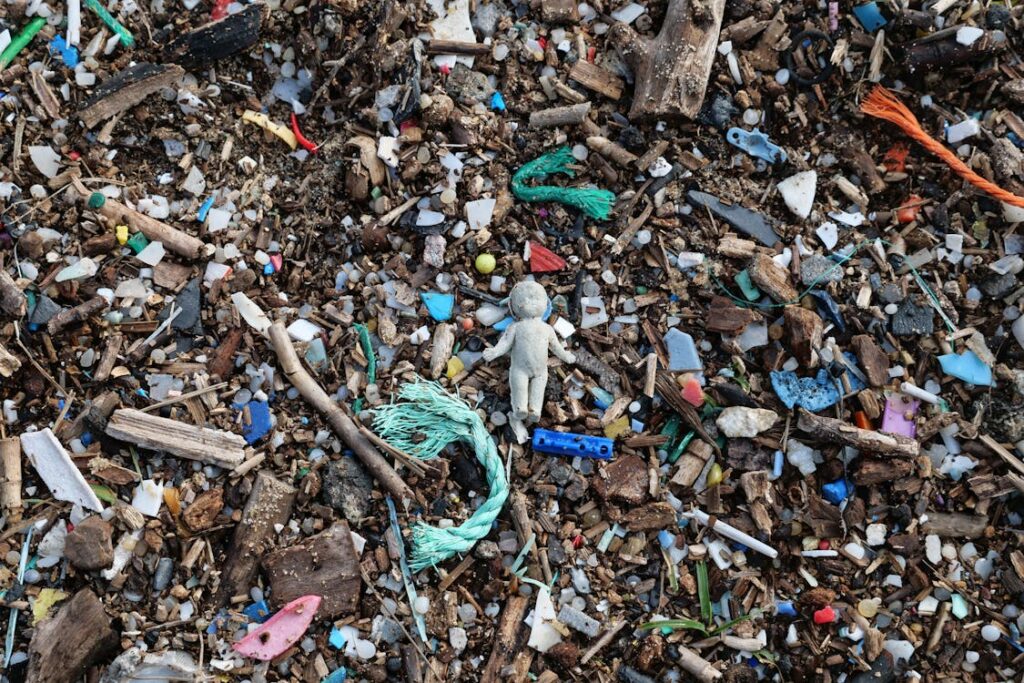Table of Contents
1. Introduction
Plastic pollution has become one of the most pressing environmental challenges of our time. Among its many forms, microplastics—tiny plastic particles less than 5 millimeters in size—pose a particularly insidious threat to both marine ecosystems and human health. These minuscule pollutants originate from various sources, including the breakdown of larger plastics, synthetic textiles, and personal care products. Once released into the environment, they travel through waterways, eventually reaching oceans where they wreak havoc on marine life. But their journey doesn’t stop there; microplastics have now been detected in seafood, drinking water, and even the air we breathe.
This blog post will explore how microplastics enter the ocean, harm marine organisms, and ultimately make their way onto our dinner plates, emphasizing why this issue demands immediate attention.
2. Main Content
What Are Microplastics?
Microplastics can be categorized into two main types:
- Primary Microplastics: These are intentionally manufactured small particles used in products like cosmetics, toothpaste, and industrial abrasives.
- Secondary Microplastics: These result from the degradation of larger plastic items such as bottles, bags, and fishing nets due to sunlight, wave action, and other environmental factors.
Once these particles enter aquatic environments, they become nearly impossible to remove because of their microscopic size. According to studies, an estimated 8 million tons of plastic waste enters the world’s oceans annually, with much of it breaking down into microplastics over time.
Step-by-Step Journey of Microplastics
Understanding the lifecycle of microplastics is crucial to grasping their pervasive impact. Here’s how they infiltrate marine ecosystems and eventually reach humans:
Step 1: Entry Points into Water Systems
Microplastics primarily enter water systems through several pathways:
- Urban Runoff: Rainwater carries microplastics from streets, sidewalks, and landfills into rivers and streams.
- Wastewater Treatment Plants: Many treatment facilities fail to filter out microfibers from washing machines or microbeads from personal care products.
- Industrial Discharge: Factories release plastic pellets and fragments directly into water bodies.
Step 2: Transport Through Rivers and Oceans
Once in waterways, microplastics are carried by currents across vast distances. They accumulate in areas known as “garbage patches,” massive gyres of floating debris driven by wind and ocean circulation patterns. The Great Pacific Garbage Patch, for example, spans an area three times the size of France.
Step 3: Interaction with Marine Life
In the ocean, microplastics interact with marine organisms at every level of the food chain:
- Plankton: Tiny zooplankton mistake microplastics for food, ingesting them and passing them up the food chain.
- Fish and Shellfish: Larger marine animals consume contaminated prey or directly ingest microplastics while feeding.
- Seabirds and Marine Mammals: Top predators suffer from bioaccumulation, accumulating high concentrations of toxins absorbed by microplastics.
Step 4: Human Consumption
Humans encounter microplastics primarily through seafood consumption. A study found that people who regularly eat shellfish may ingest up to 11,000 microplastic particles per year. Additionally, microplastics have been detected in:
- Bottled water
- Tap water
- Salt
- Even fruits and vegetables grown in soil contaminated with plastic residues
Impact on Marine Life
The effects of microplastics on marine ecosystems are devastating and multifaceted:
Physical Harm
- Blockages: Ingested microplastics can block digestive tracts, leading to starvation and death.
- Toxicity: Plastics often contain harmful additives like phthalates and bisphenol A (BPA), which leach into marine organisms’ bodies.
Chemical Contamination
Microplastics act as sponges, absorbing toxic chemicals from surrounding seawater. When ingested, these toxins transfer to marine life, disrupting hormonal balances and reproductive cycles.
Behavioral Changes
Research shows that exposure to microplastics alters the behavior of fish and other marine creatures, making them more vulnerable to predators and reducing their ability to reproduce successfully.
| Species Affected | Type of Impact |
|---|---|
| Zooplankton | Reduced growth rates |
| Fish | Impaired cognitive function |
| Seabirds | Increased mortality rates |
Human Health Risks
While research on the direct health impacts of microplastics on humans is still ongoing, early findings raise significant concerns:
Potential Health Effects
- Inflammation: Microplastics could trigger inflammatory responses in the gut lining.
- Chemical Exposure: Additives and absorbed pollutants might disrupt endocrine systems.
- Immune System Suppression: Chronic exposure may weaken immune defenses.
Broader Implications
Beyond individual health risks, microplastic contamination threatens global food security. As fisheries decline due to polluted waters, communities reliant on seafood face economic hardship and malnutrition.
“Every piece of plastic ever made still exists today unless it has been burned or recycled—but even then, traces remain.” – Environmental Scientist
3. Conclusion
The infiltration of microplastics into marine ecosystems represents a grave environmental crisis with far-reaching consequences for biodiversity and human well-being. From contaminating plankton to appearing on our dinner plates, these invisible invaders highlight the interconnectedness of all life forms. Addressing this issue requires collective action—from reducing single-use plastics to improving waste management infrastructure globally.
By raising awareness and advocating for sustainable practices, we can mitigate the spread of microplastics and protect future generations from their harmful effects.
4. Additional Information
For those interested in learning more about microplastics and taking action against plastic pollution, here are some resources:
- Documentaries: A Plastic Ocean, Blue Planet II
- Organizations: Ocean Conservancy, Plastic Pollution Coalition
- Tips for Reducing Plastic Use:
- Switch to reusable bags, bottles, and containers.
- Avoid products containing microbeads.
- Support policies aimed at curbing plastic production.
Together, we can turn the tide on plastic pollution and safeguard our planet for years to come.




